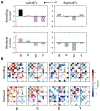Dynamic Theta Networks in the Human Medial Temporal Lobe Support Episodic Memory
- PMID: 30905609
- PMCID: PMC6445741
- DOI: 10.1016/j.cub.2019.02.020
Dynamic Theta Networks in the Human Medial Temporal Lobe Support Episodic Memory
Abstract
The medial temporal lobe (MTL) is a locus of episodic memory in the human brain. It is comprised of cytologically distinct subregions that, in concert, give rise to successful encoding and retrieval of context-dependent memories. However, the functional connections between these subregions are poorly understood. To determine functional connectivity among MTL subregions, we had 131 subjects fitted with indwelling electrodes perform a verbal memory task and asked how encoding or retrieval correlated with inter-regional synchronization. Using phase-based measures of connectivity, we found that synchronous theta (4-8 Hz) activity underlies successful episodic memory. During encoding, we observed a dynamic pattern of connections converging on the left entorhinal cortex, beginning with the perirhinal cortex and shifting through hippocampal subfields. Retrieval-associated networks demonstrated enhanced involvement of the subiculum and CA1, reflecting a substantial reorganization of the encoding network. We posit that coherent theta activity within the MTL marks periods of successful memory, but distinct patterns of connectivity dissociate key stages of memory processing.
Keywords: ECoG; LFP; connectivity; entorhinal cortex; episodic memory; hippocampus; networks; theta.
Copyright © 2019 Elsevier Ltd. All rights reserved.
Conflict of interest statement
Declaration of Interests
The authors declare no competing interests.
Figures







Similar articles
-
Electrical Stimulation in Hippocampus and Entorhinal Cortex Impairs Spatial and Temporal Memory.J Neurosci. 2018 May 9;38(19):4471-4481. doi: 10.1523/JNEUROSCI.3049-17.2018. Epub 2018 Apr 10. J Neurosci. 2018. PMID: 29636396 Free PMC article.
-
Synchronous Theta Networks Characterize Successful Memory Retrieval.J Neurosci. 2025 Apr 16;45(16):e1332242025. doi: 10.1523/JNEUROSCI.1332-24.2025. J Neurosci. 2025. PMID: 40032520
-
Human retrosplenial cortex displays transient theta phase locking with medial temporal cortex prior to activation during autobiographical memory retrieval.J Neurosci. 2013 Jun 19;33(25):10439-46. doi: 10.1523/JNEUROSCI.0513-13.2013. J Neurosci. 2013. PMID: 23785155 Free PMC article.
-
[Functional neuroimaging studies of episodic memory--functional dissociation in the medial temporal lobe structures].Brain Nerve. 2008 Jul;60(7):833-44. Brain Nerve. 2008. PMID: 18646623 Review. Japanese.
-
Theta rhythm and the encoding and retrieval of space and time.Neuroimage. 2014 Jan 15;85 Pt 2(0 2):656-66. doi: 10.1016/j.neuroimage.2013.06.022. Epub 2013 Jun 14. Neuroimage. 2014. PMID: 23774394 Free PMC article. Review.
Cited by
-
Functional specialization and interaction in the amygdala-hippocampus circuit during working memory processing.Nat Commun. 2023 May 22;14(1):2921. doi: 10.1038/s41467-023-38571-w. Nat Commun. 2023. PMID: 37217494 Free PMC article.
-
MRIES: A Matlab Toolbox for Mapping the Responses to Intracranial Electrical Stimulation.Front Neurosci. 2021 Jun 14;15:652841. doi: 10.3389/fnins.2021.652841. eCollection 2021. Front Neurosci. 2021. PMID: 34194294 Free PMC article.
-
Neurons in the human medial temporal lobe track multiple temporal contexts during episodic memory processing.Neuroimage. 2021 Dec 15;245:118689. doi: 10.1016/j.neuroimage.2021.118689. Epub 2021 Nov 3. Neuroimage. 2021. PMID: 34742943 Free PMC article.
-
Hippocampal theta activity during encoding promotes subsequent associative memory in humans.Cereb Cortex. 2023 Jun 20;33(13):8792-8802. doi: 10.1093/cercor/bhad162. Cereb Cortex. 2023. PMID: 37160345 Free PMC article.
-
Differential online and offline effects of theta-tACS on memory encoding and retrieval.Cogn Affect Behav Neurosci. 2024 Oct;24(5):894-911. doi: 10.3758/s13415-024-01204-w. Epub 2024 Jul 31. Cogn Affect Behav Neurosci. 2024. PMID: 39085585 Free PMC article.
References
-
- Eichenbaum H (2000). A cortical-hippocampal system for declarative memory. Nat. Rev. Neurosci 1, 41–50. - PubMed
-
- Paller KA, and Wagner AD (2002). Observing the transformation of experience into memory. Trends Cogn. Sci 6, 93–102. - PubMed
-
- Ranganath C, Heller A, Cohen MX, Brozinsky CJ, and Rissman J (2005). Functional connectivity with the hippocampus during successful memory formation. Hippocampus 15, 997–1005. - PubMed
-
- Vincent JL, Snyder AZ, Fox MD, Shannon BJ, Andrews JR, Raichle ME, and Buckner RL (2006). Coherent Spontaneous Activity Identifies a Hippocampal-Parietal Memory Network. J. Neurophysiol 96, 3517–3531. - PubMed
Publication types
MeSH terms
Grants and funding
LinkOut - more resources
Full Text Sources
Miscellaneous

